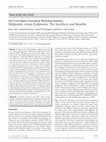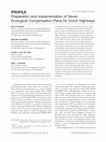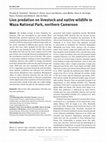Papers by Helias Udo de Haes

Public Administration, 2002
The report describes the flow of manuscripts and the contents of the journal before briefly surve... more The report describes the flow of manuscripts and the contents of the journal before briefly surveying each section of the journal. It ends with a résumé of changes during the year and a thank you to the many people who have helped. MANUSCRIPTS Table 1 shows the total number of manuscripts submitted in 2001 and their distribution between the main and the European Forum sections of the journal. There has been a constant flow of material to the 'Main Articles' section. Overall, we accepted 26 per cent of the papers submitted in 2001; rejected 32 per cent; with 41 per cent either 'revise and resubmits' or still waiting for referees' reports. The flow of articles to 'European Forum' fell by some 40 per cent. Despite problems with late referees' reports, the average transaction time for manuscripts submitted to the 'Main Articles' section was 42 days. Allowing for the time taken to process the article in the office, nearly all authors get a reply within 2 months. Unfortunately, there is always an exception. We sent a total of 140 reminders to referees (out of 298 transactions). The problem was more acute for the 'European Forum'. Most articles were turned around in six months or less but a significant number took longer.

Int J Life Cycle Assess, 2000
, the third in a series of international workshops was held under the um brella of UNEP addressin... more , the third in a series of international workshops was held under the um brella of UNEP addressing issues in Life Cycle Impact Assess ment (LCIA). The workshop provided a forum for experts to dis cuss midpoint vs. endpoint modeling. Midpoints are considered to be links in the cause-effect chain (environmental mechanism) of an impact category, prior to the endpoints, at which charac terization factors or indicators can be derived to reflect the rela tive importance of emissions or extractions. Common examples of midpoint characterization factors include ozone depletion potentials, global warming potentials, and photochemical ozone (smog) creation potentials. Recently, however, some methodolo gies have adopted characterization factors at an endpoint level in the cause-effect chain for all categories of impact (e.g., human health impacts in terms of disability adjusted life years for carcinogenicity, climate change, ozone depletion, photochemical ozone creation; or impacts in terms of changes in biodiversity, etc.). The topics addressed at this workshop included the implica tions of midpoint versus endpoint indicators with respect to un certainty (parameter, model and scenario), transparency and the ability to subsequently resolve trade-offs across impact categories using weighting techniques. The workshop closed with a consen sus that both midpoint and endpoint methodologies provide use ful information to the decision maker, prompting the call for tools that include both in a consistent framework.
Sci Total Envir, 1995
The present and future of integrated coastal zone management (ICZM) in Europe is discussed with a... more The present and future of integrated coastal zone management (ICZM) in Europe is discussed with an emphasis on nature conservation. The position of nature conservation in physical planning and in legislation is discussed within the historical perspective of the Netherlands. With regard to the present position of nature conservation in planning and legislation, differences in Europe between the northwest, the south and the east are discussed. The roles of various organisations (such as NGOs, GOs, Universities and the European Union) in ICZM is briefly mentioned. The paper advocates a strong position for nature conservation in integrated coastal zone management if it is to be developed on a sustainable basis. SSDf 0169-2046(95)00234-O * Corresponding author. important both in terms of nature conservation and in terms of social and economic development.
... Prof .dr. Hans Opschoor Institute of Social Studies, Den Haag Inleiding Rio staat hier voor d... more ... Prof .dr. Hans Opschoor Institute of Social Studies, Den Haag Inleiding Rio staat hier voor de VN-Conferentie voor Milieu en Ontwikkeling (UNCED, Rio de Janeiro, juni 1992) en haar intentie: een nieuw pact tussen Noord en Zuid gericht op duurzame mondiale ontwikkeling. ...

Environmental management, 2002
First-generation compensation plans (CPs) for Dutch highway projects have been evaluated with res... more First-generation compensation plans (CPs) for Dutch highway projects have been evaluated with respect to implementation of the compensation principle (1993), which aims to counterbalance the adverse ecological impacts of large-scale development projects. Decision-making on the seven projects took place between 1993 and 1995. Specifically, we considered: (a) the processes employed to prepare and implement the compensation plans; (b) the methods used to identify, plan, and execute the compensation measures; and (c) the results yielded by these methods. We conclude that the CPs were prepared fairly uniformly, particularly in terms of the processes and methodologies used to derive compensation measures. Five of the seven CPs had become operational by 2001 and initial experience is now being gained on land acquisition and transfer of compensation sites to nature conservation trusts. Further progress of CPs is likely to be seriously hampered by growing demand for land for development in g...

Eco-Efficiency in Industry and Science, 2002
ABSTRACT The decision processes described in Chapter 2 can be supported by different types of inf... more ABSTRACT The decision processes described in Chapter 2 can be supported by different types of information related to a chain perspective, as shown in Figure 3.1. The decision process is an interactive process where the results from one type of analysis can lead to the demand for more information. The shown framework makes a distinction between concepts and tools as suggested by the LCANET working group on Positioning and Application of LCA (Cowell et al., 1997; Wrisberg and Gameson, 1998). Concepts are defined as an idea on how to achieve sustainability, such as life cycle thinking, design for the environment, and cleaner technology. Tools, on the other hand, are operational methods supporting the concepts. They are structured vehicles for reasoning, analysis and communication. Analytical tools, provide technical information as to the consequences of a choice, while procedural tools focus on procedures to guide the way to reach a decision. All types of tools are supported by technical elements, such as mass balance models, evaluation models and quality assessment. The technical elements may also stand alone to be used to support the decision process. The technical elements are supported by data. Figure 3.1 Framework for the supply side.

Eco-Efficiency in Industry and Science, 2002
ABSTRACT One of the main purposes of this book is to make a link between the supply and demand of... more ABSTRACT One of the main purposes of this book is to make a link between the supply and demand of analytical tools concerning environmental information. The reason is that it is not clear for which problems a specific tool is most appropriate, or whether more than one tool should be applied, especially in determining the net overall effects of any given decision. Furthermore, it is a reaction to the fact that we often find a gap and a lack of communication between the developers of such tools — typically stemming from academic research — and the users of tools from industry and government. Such lack of co-ordination can lead to situations where tool developers dedicate a huge amount of resources to create highly sophisticated tools that find little practical application, and at the same time industry is lacking instruments to meet the steadily increasing demand for environmental evaluation.
Landscape Ecology, 1994
A hierarchical paradigm may help to better understand patterns of ecosystems. In this article we ... more A hierarchical paradigm may help to better understand patterns of ecosystems. In this article we present and argue a framework for hierarchical ecosystem classification and mapping. It is based on a hierarchical model of an ecosystem fully incorporating abiotic components. We propose a nomenclature for hierarchical ecosystem classification based on common practice in ecological land classification and considerations on comprehensiveness which is inspired on and closely follows the Canadian terminology, but incorporating some frequently used European concepts. The relation between classification characteristics and the spatial and temporal hierarchy of ecosystem components is discussed. We exemplify that the approach is particularly valuable as a comprehensive tool for scientific analyses on behalf of environmental policy.

Oryx, 2013
Conflict between humans and lions Panthera leo is a key factor driving population declines of lio... more Conflict between humans and lions Panthera leo is a key factor driving population declines of lions in Africa, especially in communal lands and on the edges of small protected areas. We assessed this conflict in Waza National Park, Cameroon, in 2008 through an interview survey. A total of 207 resident and 174 nomadic pastoralists were interviewed. Results indicated high levels of livestock depredation around the Park, with attacks occurring most often at night. Lions were economically a substantial threat accounting for total losses of EUR 100,000 per annum. Per household, resident pastoralists lost one cow and nomadic pastoralists two cows per annum, equating to c. EUR 260 and 520, respectively. To mitigate these losses resident pastoralists used enclosures for nocturnal protection of their livestock more than nomadic pastoralists, who tended to herd livestock more during pasture. Improved mitigation methods pertaining to herding practice, the use of enclosures and the presence of ...
In Search of Indicators of Sustainable Development, 1991
In environmental policy the concept of sustainability refers to a sustainable relationship betwee... more In environmental policy the concept of sustainability refers to a sustainable relationship between society and environment (see Figure 1).
Environment & Policy, 1998

The International Journal of Life Cycle Assessment
It all started with a new version of the environmental scheme drafted by Helias Udo de Haes and E... more It all started with a new version of the environmental scheme drafted by Helias Udo de Haes and Erwin Lindeijer in November 2000 for use in the final phase of SETAC Europe's 2nd Working group on (life cycle) Impact Assessment (WIA-2). This group convened the day after the 8th LCA Case Studies Symposium in Brussels, Dezember 1, 2000. There was not enough time during this meeting to discuss the new scheme in detail, which contained an additional Area of Protection (AoP) or Safeguard Subject (SaSu) Life Support System (LSS). This new AoP or SaSu has been suggested in order to represent the partly inanimate subsystems of the ecosystem earth which are the basis for live on this planet, as we humans know it and are part of it. These systems (e.g. the stratospheric ozone layer, the climate system and the biogeochemical cycles or the fertility of soils) are in general not considered to have a societal value in itself, but rather to be supportive for the immediately convincing SaSus or A...

Science of The Total Environment, 1993
On a series of field sites with thermally cleaned soils and their adjacent natural soils the avai... more On a series of field sites with thermally cleaned soils and their adjacent natural soils the availability of Pb, Cu, Zn and Cd for Ryegrass (Lolium perenne) and Creeping Bent (Agrostis stolonifera) was investigated as part of a research program, 'Ecological recovery of cleaned soil'. The thermally cleaned field soils can be characterized as alkaline, loam-poor, sandy soils, whilst their adjacent field soils display several soil types. Compared to governmental quality standards all thermally cleaned and half of the adjacent field soils can be classified as lightly or moderately polluted. The standardized extractable amounts of Zn and Cu are lower in the thermally cleaned field soils, but possibly higher for Pb. The standardized contents of heavy metals in grasses are in general (significantly for Zn and Cd) lower in thermally cleaned field soils. In the cleaned and in the adjacent field soils a clear interference between the Cd uptake and the Cu and Zn content of the soil was notable. Heavy metal levels do not exceed toxic limits for plant growth, but partly exceed toxic limits for sheep. In the future an increase in the availability can be expected because of the steadily declining pH.
Marine Mammal Science, 1998

mammalia, 2000
The feeding ecology of lions ( Panthera leo, Linnaeus 1758) was investigated in and around Waza N... more The feeding ecology of lions ( Panthera leo, Linnaeus 1758) was investigated in and around Waza National Park, northern Cameroon. Diet was determined using global positioning system (GPS) data of lion kill sites (clusters of GPS location points) collected using radio collars. Lions consumed 14 different prey species, with five species that were either medium (50 -200 kg) or large ( > 200 kg) in size forming the bulk of kills. The western kob ( Kobus kob kob ) was the most common (23.5 % ) wild prey of lions, but worryingly livestock (predominantly cattle) constituted as much as 21.6 % of the diet. This creates a conservation problem resulting in lions being killed in retaliation. However, this conflict is strongly exacerbated by herders driving their cattle into the park for forage and water. Wild prey was also consumed outside the park (6.7 % ), suggesting excursions beyond the park boundary. Lions showed a preference for wild prey over livestock when relative abundances were considered. Management efforts to reduce livestock intrusion into the park and to reverse the declining trends of wild prey populations would significantly reduce predation of livestock and prevent persecution of lions in this park, but conflict mitigation measures outside the park are also urgently needed.
Journal of Industrial Ecology, 1997








Uploads
Papers by Helias Udo de Haes